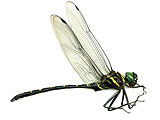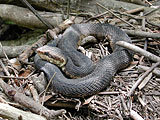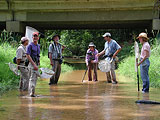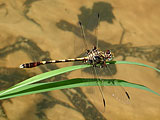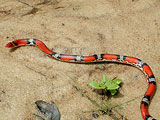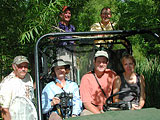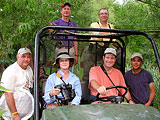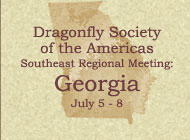
Southwest Georgia, July 5 - 8, 2007
Two days after returning home from Maine, I was off again to the Southeast regional meeting of the Dragonfly Society of the Americas hosted by Giff Beaton. I wasn't sure what we would find at the meeting. The southwestern part of Georgia is poorly known and we would be covering some new ground. Our main hope was for southern Emeralds (Somatochloras) since the habitat was similar to areas with known populations in the nearby Florida panhandle. In any case, it would be fun to join another group of enthusiastic dragonfly hunters for the weekend.
July 5: I flew into Tallahassee. It was much closer to Bainbridge, GA than Atlanta and I was planning to look for dragonflies in Florida after the meeting. After I landed I still had time to check out Lost Lake near the airport and found a few Belle's Sanddragons, Progomphus bellei still flying. I had seen them way back at the beginning of May. I hoped to find a female but came up empty again. It was getting late so I drove on to Bainbridge by dinnertime.
The first meeting participants I ran into were Gayle and Jeanell Strickland in the lobby of the motel. I had met them a few years ago at the last DSA survey of Eglin Air Force Base in Florida. They are trying to get scans of every odonate recorded in their home State of Louisiana, males and females. They maintain a website that is a fantastic odonate resource, check them out at http://public.fotki.com/gstrick3.
After supper, most of our group of twelve headed out to see what we could find at a stream crossing and a nearby powerline cut. It was fairly quiet, a few Royal River Cruisers, Macromia taeniolata were found along the powerline, and Fawn Darners, Boyeria vinosa were observed on the stream with the aid of a flashlight.
July 6: The next morning was too cloudy and cool for anything flying, unexpected weather for Georgia in July. We had divided into two groups, each heading to different streams. I joined Giff, Marion Dobbs, and Michael Veit and walked a nice looking creek for a couple of hours without finding much. When we reassembled in Bainbridge for lunch, the other group hadn't fared any better.
After lunch the weather improved, and it was decided that we would go back to Little Attapulgus Creek, where we had spent a little time in the morning. It's a pretty sand-bottomed creek and we did have a few interesting sightings. A large clubtail with a bright orange tail-tip flew by and I swung my net and missed. It probably was a Two-striped Forceptail, Aphylla williamsoni but Giff suggested the only other thing it could have been was Southeastern Spinyleg, Dromogomphus armatus. This was one of my main targets for the trip so not catching it didn't make me feel any better. Later Steve Krotzer did catch a male Forceptail. We had a Comet Darner, Anax longipes fly by, someone caught a male Cyrano Darner, Nasiaeschna pentacantha which refused to cooperate for a good photograph. It perched long enough but held its abdomen in an unnatural looking S-curve and resisted all of Giff's attempts to straighten it out. Later as we were considering leaving the stream, a dragonfly most likely a Laura's Clubtail, Stylurus laurae flew in to lay eggs. It landed briefly but an avoided an attempt to catch her. But the sightings were few and far-between. I found a lazy Cottonmouth and Jerrell Daigle found a dead Scarlet Snake which we took turns taking pictures of.
July 7: We headed out to Williams Bluff, a Nature Conservancy property in Early Co. that Giff had been surveying. It is home of a Snaketail (Ophiogomphus) species which I had seen at the end of March so the adults would no longer be flying. Again the day started with cool temperatures and we weren't finding very much at our first stop, certainly not any Emeralds. I was hoping to find a damselfly I haven't seen before, the Purple Bluet, Enallagma coecum/cardenium but they were also absent.
Our second stop on the property was a powerline cut that was crossed by a couple of streams. This is the site were we found the Snaketails in March. Hot and dry, there was very little in the open areas. I had pretty much given up when Marion Dobbs came to fetch us, saying she just saw a Southeastern Spinyleg and had a digital picture to prove it. Dennis Paulson and I followed her back to where she last saw it, along the stream but under tree cover. I ducked under and a few minutes later saw a female perched on an overhanging branch above the stream. As I moved closer she took off and flew down the stream. I saw her a couple more tantalizing times until she dipped quickly in the stream and flew up high away from us. Darn! But as we had been following the female, Steve Krotzer caught a male Spinyleg in the open near the stream.
But under the trees was where the action was. Giff and others had success in netting Arrowhead Spiketails, Cordulegaster obliqua. These were considered the subspecies fasciata and they are much bigger than the obliqua I find in the Northeast. Jerrell Daigle thinks they are a separate species. One difference is the eyes are supposed to be blue in the South but when we held two males together, one had green eyes, the other blue. Giff had also broken our Emerald drought, netting a male Clamp-tipped, Somatochlora tenebrosa along the stream.
I would have liked to have stayed longer to seek a female Spinylegs but we moved on to Kolomoki Mounds SP. There were more Two-striped Forceptails along a large lake, and we added a number of new species for the meeting including Gray-green Clubtails, Arigomphus pallidus. I was happy to see Smoky Rubyspot, Hetaerina titia for the first time this year.
July 8: Only half of the meeting participants continued on Sunday with a visit of the private McFadden property in Seminole Co. Seminole is one of the least surveyed counties in Georgia so even our quick look in less than ideal weather produced records. We were graciously greeted by Angela Hagen who led us on a safari-style tour of the parcel on small off-road vehicles called "mules," brushing and braving the slaps of wet tree limbs along the trails. After lunch we said our goodbyes and drove off in different directions. I headed south and west back into Florida.
Personally it was a strange meeting. I caught virtually none of the interesting dragonflies I got to scan. Steve Krotzer did get paid a dime for the Dromogomphus, a real bargain. Thanks Steve!
